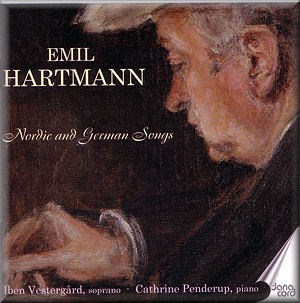 |
 |
|


alternatively
CD: MDT
AmazonUK
AmazonUS(download)
Sound
Samples & Downloads |
Emil HARTMANN (1836-1898)
Nordic and German Songs
CD 1
From ‘Five Songs’, Op.13 [5:13]
Nine Love Songs [20:18]
At the Cemetery [1:53]
Three Songs, Op.15A [7:33]
The Dying Child [5:00]
Four Songs, Op.1 [6:09]
No Hope [3:05]
Cradle Song [3:08]
Songs, Op.21 [7:47]
CD 2
Tens songs From ‘Norwegian Lyric Poetry’ [26:06]
Two Poems by Bernhard Malmstrøm [5:55]
Songs, Op.35A [17:47]
Songs, Op.35B [14:56]
 Iben Vestergård (soprano) Cathrine Penderup (piano)
Iben Vestergård (soprano) Cathrine Penderup (piano)
rec. 26-29 March, 4-5 June 2010, Søllerød, Sognegård, Denmark. DDD
 DANACORD DACOCD 712-713 [60:06 + 64:44]
DANACORD DACOCD 712-713 [60:06 + 64:44] 
|
|
|
Nordic songs – or romanser, as they often are classified – have, with a few exceptions, never been much in vogue in the rest of the world. Grieg and Sibelius are the most obvious names, and Nielsen in Denmark was also a prolific songwriter. His songs were congenially performed and recorded by Aksel Schiøtz in the 1940s and are available, together with everything he recorded up till 1945 (Danacord, 11 CDs). He also sang songs by the somewhat older Heise and Lange-Müller, both regarded as the best vocal composers of that period. Emil Hartmann belongs to that same generation and when Danacord now issue fifty of his songs, most of them never recorded before, it is an important addition to the catalogue of Danish music. There are songs in Danish, Norwegian and German and two songs in Swedish. On CD 1we are treated to 26 songs in Danish and on CD 2 the Norwegian, Swedish and German songs.
Listening through the whole set in one sitting, which I did, is not a good idea. The songs are no doubt well crafted and are agreeable but in large doses they turn out to be rather monotonous. They are far better suited to savour a few at a time. There is a lack of individuality, both structurally and in expression. Schumann, Mendelssohn maybe Brahms seem to have been the inspiration, and who better for inspiration? But to be really interesting there has to be something else as well: personality. In that respect Heise and Lange-Müller are superior. But let me hasten to add that the songs are not bad and if I go back to this set in the future I would rather dip into them instead of immersing myself in all fifty.
If I go back! And I doubt I will, since there is a further factor to take into consideration: the singing. Iben Vestergård has no doubt worked hard to study these songs and her singing is committed. However, technically there are too many limitations. Her tone is far too often shrill and unattractive. There is too little variation in vocal colours and she is quite ill-tuned at times. In the upper reaches she is sorely strained. In other words, the musical enjoyment is seriously compromised, which is a pity when the songs now are available for the first time and there is little hope of another company coming up with the same repertoire. The booklet has the sung texts but no translations, just a brief summary in English of the poems.
The recorded sound is good and the accompaniment cannot be faulted. I wish I could be more positive but with singing that too often is unsatisfying this issue can’t be recommended.
Göran Forsling
|
|

